As the evening draws to a close, and the snow thickens, sadness draws ever closer to my heart.
The project has come to a depressing end and this blog must go.
I look back on the good times and the bad with hindsight and realise I will miss this project dearly.
Sadly unlike Simon I'm not one with words, and my computer was broken so I could not finish my video blog of all the clips from our shoots. There was going to be a fantastic montage of the best times!
So for now I'll leave you with a statement that sums up the entire project;
"This car park has turned out to be a treasure trove of quality filming locations".
In the words of Stan Lee,
'Nuff said.
Final Opening Sequence - The Case
Sunday, February 1, 2009
Evaluation Question 7 : Looking back at your preliminary task, what do you feel you have learnt in the progression from it to the full product?
In the preliminary exercise I was acting and so was not able to be involved in the filming process. However during our main task I was able to be fully flexible to all roles and had an active part in the whole project. I learnt about shooting using the 180-degree rule and using master shots, both of which came in really handy in the editing sessions. Also as we chose our groups for the main task, I feel in this task I have been able to more freely speak my mind about all decisions and have good discussions about our creative differences. My filming skills have greatly improved and I can now execute most of the filming techniques we practised in the prelim task effectively.
I have learnt a lot about research having done almost none for the prelim exercise but having worked a lot with Simon on creating diagrams and reccy videos to help the group blog progress. Also from this I have learnt about blogging and working in a production team and the importance of keeping everyone in the loop. We had problems early on where people did not know what was happening at certain times but by the end of the project we were organised in making sure everyone knew what was going on.
Most of the skills I have developed have been organisation skills. I wrote the scripts for both "The Streets Run Red" and "The Case" and then we translated these into shooting scripts which helped cut down on filming time, and also on re-shoots. Without the shooting scripts we would have missed out lots of footage that we needed and wasted a lot of time on shoot. I have also learnt the importance of storyboarding, even if not fully drawing out every shot, by making diagrams of how you want something to turn out you can go back to it while filming to check if you are filming correctly.
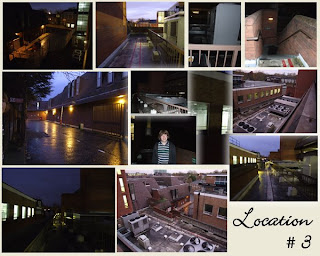 One thing I have learnt which was not relevant in the prelim task is to secure your location before planning around it. We spent around a month planning for "The Streets Run Red" in the car park but had to abandon it as we could not get permission to film there. However, filming in my house turned out to be a lot easier and we still managed to be creative with a simple idea.
One thing I have learnt which was not relevant in the prelim task is to secure your location before planning around it. We spent around a month planning for "The Streets Run Red" in the car park but had to abandon it as we could not get permission to film there. However, filming in my house turned out to be a lot easier and we still managed to be creative with a simple idea.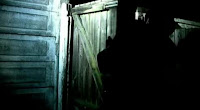 In the editing stage I learnt that you always need more footage than you think, and shots always seem longer than they actually are. This led to us taking more time on the reshoots and thinking through shots very carefully so as not to create problems in the edit room. I also learnt about the importance of a match on action, a device that we do not really notice in most films as they are done so well. The most noticeable example of a match on action in our project is the gate sequence that we are very proud of.
In the editing stage I learnt that you always need more footage than you think, and shots always seem longer than they actually are. This led to us taking more time on the reshoots and thinking through shots very carefully so as not to create problems in the edit room. I also learnt about the importance of a match on action, a device that we do not really notice in most films as they are done so well. The most noticeable example of a match on action in our project is the gate sequence that we are very proud of.In hindsight, looking at our finished project compared to our prelim task I can see how much our technique has grown and I am very happy with "The Case". I wouldn't change anything in it as I believe in the end we got all the correct shots and spent a long time editing to make the continuity correct. I am particularly happy about all the visual and audio effects we added. My claim to fame was discovering that by lowering the treble level on clips you could reduce the camera hiss picked up by wind outside. This helped make our sequence a lot more continuous.
I have really enjoyed this project and I think I can safely say I have developed my media skills greatly throughout, aiding the creation of a cracking sequence.
Evaluation Question 6 : What have you learnt about technologies from the process of constructing this product?
Throughout the project I have learnt to use and revisited the use of many technologies during the task. As we shared out the jobs equally between the group I got a good go at editing, filming, research and design work. The main technology to mention is the blogs. Having not done a blog before I have learnt about constructing posts and creating an easily accessible blog. It has helped with presenting research and contacting the group greatly and was a generally enjoyable way of expressing our work, both individually and as a group.
 Throughout the filming process we used a Canon mini HD camera with a boom mic attached. Although we did not film in HD it was a high quality camera which made the editing process easy as we could do a lot with the clips. We used headphones with the camera so that while recording sound we could make sure there were not any faults that the human ear might not pick up on. This greatly reduced the need for reshoots and the amount of takes. For our project as we were mainly outside we used the studio lighting kit. This was also a new experience and I learnt about how to assemble the lights and the use of filters (e.g. we used a blue filter to replicate the effect of moonlight). Simple problems that I have learnt to deal with is the charging of batteries for camera which takes a lot longer than we first thought it would, and also about leaving the lights to cool down as we almost burned ourselves on them a couple of times. Another thing I learnt about is the use of tripods, how to position them properly and how to use them for certain shots, especially pans, which are very difficult handheld.
Throughout the filming process we used a Canon mini HD camera with a boom mic attached. Although we did not film in HD it was a high quality camera which made the editing process easy as we could do a lot with the clips. We used headphones with the camera so that while recording sound we could make sure there were not any faults that the human ear might not pick up on. This greatly reduced the need for reshoots and the amount of takes. For our project as we were mainly outside we used the studio lighting kit. This was also a new experience and I learnt about how to assemble the lights and the use of filters (e.g. we used a blue filter to replicate the effect of moonlight). Simple problems that I have learnt to deal with is the charging of batteries for camera which takes a lot longer than we first thought it would, and also about leaving the lights to cool down as we almost burned ourselves on them a couple of times. Another thing I learnt about is the use of tripods, how to position them properly and how to use them for certain shots, especially pans, which are very difficult handheld.
I have learnt about transporting equipment as well. We had to make sure that whoever was taking the lighting kit could get a lift home as it was very heavy. The rest of the kit was all very portable and was easy to move around with us.
 To edit our project we used Adobe Premiere Pro CS3. Having used Windows Movie Maker for my GCSE media product, I had to learn to use the program from scratch. I learnt about using multiple timelines and audio tracks and how to use non-linear editing, in which we could edit the sequence in whatever order we wanted. I learnt how to use lots of the audio and visual effects such as the three-way colour corrector which allowed us to change the brightness and contrast of our clips (making them more filmic) and also lower the saturation. This tool also came in handy when the sky was slightly red on our reshoot weekend, so we could change the tint to make it fit the rest of the sequence. I learnt how to cut clips using the razor and link them together for better matches on action. Also using the source monitor to watch back original and edited clips at the same time was very useful to compare our work to the original source. I also learnt about keyframing which we used to edit the sound levels and for transitions such as fades.
To edit our project we used Adobe Premiere Pro CS3. Having used Windows Movie Maker for my GCSE media product, I had to learn to use the program from scratch. I learnt about using multiple timelines and audio tracks and how to use non-linear editing, in which we could edit the sequence in whatever order we wanted. I learnt how to use lots of the audio and visual effects such as the three-way colour corrector which allowed us to change the brightness and contrast of our clips (making them more filmic) and also lower the saturation. This tool also came in handy when the sky was slightly red on our reshoot weekend, so we could change the tint to make it fit the rest of the sequence. I learnt how to cut clips using the razor and link them together for better matches on action. Also using the source monitor to watch back original and edited clips at the same time was very useful to compare our work to the original source. I also learnt about keyframing which we used to edit the sound levels and for transitions such as fades.
To make the "Eyeless Productions" logo we used Adobe Photoshop CS3 and Adobe Fireworks CS3. I have used both of these programs before but I learnt about using the filters such a glow and halftone dots to create odd distortions on a simple image. I also learnt about layering so that different parts of the photo can be moved individually without editing the finished product.
I have learnt about transporting equipment as well. We had to make sure that whoever was taking the lighting kit could get a lift home as it was very heavy. The rest of the kit was all very portable and was easy to move around with us.
To make the "Eyeless Productions" logo we used Adobe Photoshop CS3 and Adobe Fireworks CS3. I have used both of these programs before but I learnt about using the filters such a glow and halftone dots to create odd distortions on a simple image. I also learnt about layering so that different parts of the photo can be moved individually without editing the finished product.
Evaluation Question 5 : How did you attract/address your audience?
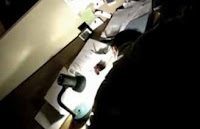 Throughout our sequence we used lots of techniques in filming, editing, style and convention to attract and address our target audience. By creating a sequence built mainly around tension we managed to appeal to the thriller genre throughout. The fact that the sequence builds up twice is particularly effective. Although the head slam at around 1 minute 30 is a big event, it leaves a feeling of enigma as the sequence still continues afterwards. The audience would have expected that to be the climax when really it is only the beginning. This uses the enigma code. By creating a new feeling of tension after the assault the audience will become intrigued as to what more could happen, as they are led to believe the detective to be dead. The ending only creates more enigma as seeing as we never actually see who is holding the gun we do not technically know from an audience perspective who the gunman is. It could be the detective or a new character all together.
Throughout our sequence we used lots of techniques in filming, editing, style and convention to attract and address our target audience. By creating a sequence built mainly around tension we managed to appeal to the thriller genre throughout. The fact that the sequence builds up twice is particularly effective. Although the head slam at around 1 minute 30 is a big event, it leaves a feeling of enigma as the sequence still continues afterwards. The audience would have expected that to be the climax when really it is only the beginning. This uses the enigma code. By creating a new feeling of tension after the assault the audience will become intrigued as to what more could happen, as they are led to believe the detective to be dead. The ending only creates more enigma as seeing as we never actually see who is holding the gun we do not technically know from an audience perspective who the gunman is. It could be the detective or a new character all together.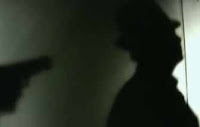 Shooting the scene at night time appeals to the audience as crime is often associated with night time. On our questionnaire many people's favourite film was "The Dark Knight" (Christopher Nolan, 2008) a film set almost all at night time. It gives a mysterious sense and helps with the build up of tension and enigma so we thought to address the audience in this way also. Also there is the point that in darkness not everything is visible. Although we chose not have anything jump out from the shadows, it is very common in Thriller so the audience could have been expecting some sort of surprise as the sequence continued.
Shooting the scene at night time appeals to the audience as crime is often associated with night time. On our questionnaire many people's favourite film was "The Dark Knight" (Christopher Nolan, 2008) a film set almost all at night time. It gives a mysterious sense and helps with the build up of tension and enigma so we thought to address the audience in this way also. Also there is the point that in darkness not everything is visible. Although we chose not have anything jump out from the shadows, it is very common in Thriller so the audience could have been expecting some sort of surprise as the sequence continued.By not using dialogue and keeping the scene very linear and seamless, we attracted the audience by making it simple. The audience would be able to easily watch the film without having to think too deeply into the plot or be distracted by dialogue. This allowed us to focus in on important clues which later in the film would be revealed. The music also helped as although it was in the background and not distracting from the plot, it built tension throughout, being eerie and atmospheric.
 The location is very good for addressing our target audience. It is an ordinary middle class home with a small garden, that would look similar to most houses of the sort in London. The audience would be able to relate to familiar feelings areas and therefore relate more with the characters.
The location is very good for addressing our target audience. It is an ordinary middle class home with a small garden, that would look similar to most houses of the sort in London. The audience would be able to relate to familiar feelings areas and therefore relate more with the characters.
Evaluation Question 4 : Who would be the audience for your media product?
When creating our opening sequence we had the idea of making a film for a cult audience. In developing the audience we had ourselves in mind, as without particularly meaning to, we made a film that we would enjoy watching. We are fans of Thriller and Film Noir and this is where I think our primary audience would lie. Here is a short profile of what sort of person would watch our film in my opinion. I have also taken into account the results from our questionnaire:
Age : 16-30
Gender : Male
Job : Most probably an office job, nothing too specialised
Favourite Genre of Film : Thriller/Crime
 Our film would probably have only a national audience as in Question 3 I pointed out that it would be unlikely to be shown worldwide. Our secondary audience could relate to a few different groups. I think our film could be liked by people who work in the arts, as it uses lots of stylistic features in the lighting and editing, and also people in the same line of work as the protagonist. Mentioned in Question 2, a fellow detective might relate to the feeling of stress that our main character feels and find the film interesting on that level.
Our film would probably have only a national audience as in Question 3 I pointed out that it would be unlikely to be shown worldwide. Our secondary audience could relate to a few different groups. I think our film could be liked by people who work in the arts, as it uses lots of stylistic features in the lighting and editing, and also people in the same line of work as the protagonist. Mentioned in Question 2, a fellow detective might relate to the feeling of stress that our main character feels and find the film interesting on that level.
People who enjoyed the films "Sin City" and "Blade Runner" would probably also enjoy our film as they were our main inspirations in style and character types, as we followed conventions and stereotypes from each throughout.
Age : 16-30
Gender : Male
Job : Most probably an office job, nothing too specialised
Favourite Genre of Film : Thriller/Crime
 Our film would probably have only a national audience as in Question 3 I pointed out that it would be unlikely to be shown worldwide. Our secondary audience could relate to a few different groups. I think our film could be liked by people who work in the arts, as it uses lots of stylistic features in the lighting and editing, and also people in the same line of work as the protagonist. Mentioned in Question 2, a fellow detective might relate to the feeling of stress that our main character feels and find the film interesting on that level.
Our film would probably have only a national audience as in Question 3 I pointed out that it would be unlikely to be shown worldwide. Our secondary audience could relate to a few different groups. I think our film could be liked by people who work in the arts, as it uses lots of stylistic features in the lighting and editing, and also people in the same line of work as the protagonist. Mentioned in Question 2, a fellow detective might relate to the feeling of stress that our main character feels and find the film interesting on that level.People who enjoyed the films "Sin City" and "Blade Runner" would probably also enjoy our film as they were our main inspirations in style and character types, as we followed conventions and stereotypes from each throughout.
Evaluation Question 3 : What kind of media instituion might distribute your media product and why?
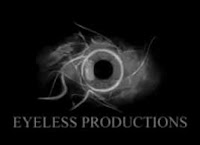 For our opening sequence we came up with the independent film company "Eyeless Productions". We decided that it would be a company for mainly thriller/horror films trying to reach a cult audience. We thought this would be suitable seeing as Film Noir is nowadays a very cult genre with rarely any true Film Noir being made and it being used more as an inspiration for cross genre productions. Were we trying to sell our film to a real film company it would be unlikely that we would try with someone like Paramount or Universal as they are very big mainstream companies who would be against the idea of a cult film, wanting rather to distribute hugely successful blockbusters.
For our opening sequence we came up with the independent film company "Eyeless Productions". We decided that it would be a company for mainly thriller/horror films trying to reach a cult audience. We thought this would be suitable seeing as Film Noir is nowadays a very cult genre with rarely any true Film Noir being made and it being used more as an inspiration for cross genre productions. Were we trying to sell our film to a real film company it would be unlikely that we would try with someone like Paramount or Universal as they are very big mainstream companies who would be against the idea of a cult film, wanting rather to distribute hugely successful blockbusters.As the film "Saw" (James Wan - 2004) was an independent film (which has gained a huge cult fanbase) and is a horror (similar in ways to the thriller genre) I thought it would be good to look at the distributers involved in its release (found here). I think a company like Twisted Pictures or Evolution Entertainment would be interested in our film, having led many other films from unknown to cult status and being small companies, suited to our needs.
If released as a full motion picture, our film with backing from a company like Twisted Pictures, could reash mainstream cinemas such as Cineworld and Odeon in Britain. Being a British film it would probably only be shown in British cinemas and if it was successful could achieve a world wide release.
To distribute our film, the company would probaly use an advert campaign. As our target audience is mainly 16-25 year old males, a good place to target them would be public transport, as most late teen males would be using it every day to travel to school/college/work.
 As an opening sequence our film opening could be shown at independent film festivals such as Raindance festival. When we asked in our questionairre about what type of cinema would show our opening most responded with the option "The Phoenix", a local cinema which often hosts small film festivals and student film festivals. To broadcast our film we had a screening at school which we organised ourselves. We created an advert campaign in which we designed a poster, which we stuck up around school and also on a facebook group, which we invited people from our year to, to notify them about the screening and the details about it.
As an opening sequence our film opening could be shown at independent film festivals such as Raindance festival. When we asked in our questionairre about what type of cinema would show our opening most responded with the option "The Phoenix", a local cinema which often hosts small film festivals and student film festivals. To broadcast our film we had a screening at school which we organised ourselves. We created an advert campaign in which we designed a poster, which we stuck up around school and also on a facebook group, which we invited people from our year to, to notify them about the screening and the details about it.Also our film has now been put on youtube and can be viewed by anyone on the internet (Shown at the top of this blog). Were it a full length production, we would post a trailer on youtube to gain interest.
Evaluation Question 2 : How does your media product represent particular social groups?
In our opening sequence the representation of social groups was obviously shown through the characters and actors involved. Both were male actors between 16-20. By choosing actors in this age and gender we hoped to follow conventions of Film Noir (e.g. young detective who is tricked by a clever Femme Fatale) and bring across common characters to the audience that they can relate with. For instance working men would know that with a job like being a detective he would stay up late at night working with high levels of stress, giving the character a human feel.
We chose two white, middle class actors to play our characters;
Jon - the Detective (19)
Andrew - the Villain (17)
 Both actors are meant to be slightly older than their real age but as it was a student film we could not hire professional actors. In my blog on the group page "Character Comparisons" I showed characters similar to our detective and villain. Both Harrison Ford and Bruce Willis shown in that post would have been suitable (at a younger age) to play the parts in our film and because they have both been in similar style films before, the audience would feel confident going to see our film, knowing that they would suit the roles (Bruce Willis - Sin City, Harrison Ford - Blade Runner (Ridley Scott, 1982)).
Both actors are meant to be slightly older than their real age but as it was a student film we could not hire professional actors. In my blog on the group page "Character Comparisons" I showed characters similar to our detective and villain. Both Harrison Ford and Bruce Willis shown in that post would have been suitable (at a younger age) to play the parts in our film and because they have both been in similar style films before, the audience would feel confident going to see our film, knowing that they would suit the roles (Bruce Willis - Sin City, Harrison Ford - Blade Runner (Ridley Scott, 1982)).
 By choosing working class we have represented the majority of the population of Britain which represents fairly an archetypal image, also by choosing to have them white (most detectives in typical Film Noir are white working class males, like Walter Neff (Fred MacMurray) in Double Indemnity).
By choosing working class we have represented the majority of the population of Britain which represents fairly an archetypal image, also by choosing to have them white (most detectives in typical Film Noir are white working class males, like Walter Neff (Fred MacMurray) in Double Indemnity).
For a more in depth look at Jon's character "The Detective", there is a blog on the group page which can be found here;
The Detective
We chose two white, middle class actors to play our characters;
Jon - the Detective (19)
Andrew - the Villain (17)
For a more in depth look at Jon's character "The Detective", there is a blog on the group page which can be found here;
The Detective
Subscribe to:
Comments (Atom)